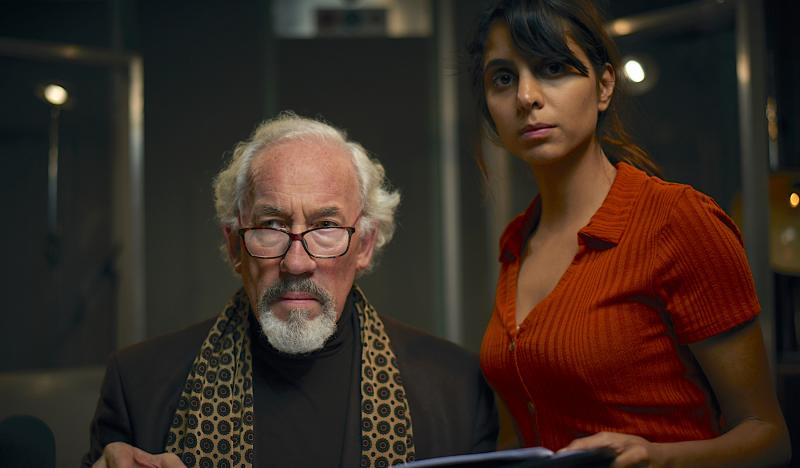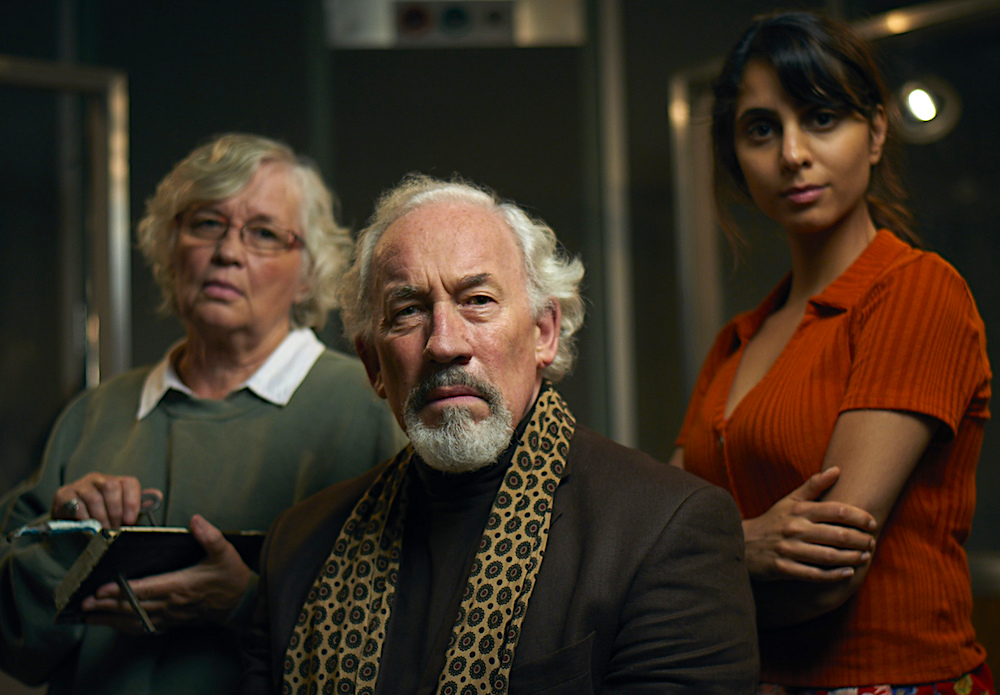The Dead Room, BBC Four review - ghosts at the microphone | reviews, news & interviews
The Dead Room, BBC Four review - ghosts at the microphone
The Dead Room, BBC Four review - ghosts at the microphone
Simon Callow shines in Mark Gatiss's supernatural tale

Fired by the spirit of the MR James ghost stories which used to be a Christmas staple on the BBC, Mark Gatiss conceived this amusing bonne bouche as both a seasonal chiller and a nod to the ghost of broadcasting past.
His vehicle for this was the venerable thespian Aubrey Judd, host of the long-running radio show The Dead Room when he's not picking up TV bit-parts as "dementia man 2". As he described it himself, in his fulsome and fruity and r-rolling baritone, “Aubrey Judd, bringing mild disquiet to radio listeners since 1976”. No-one could have done this better than Simon Callow, who took to the role with all-consuming gusto, bringing to mind generations of old-school actors who have struggled to readjust to changing times and galloping technology. "There's no privacy any more, not a scrap," he wailed, in a rant about the iniquities of social media.
Pompous and self-obsessed, inclined to deliver didactic speeches about how things were done in the old days (and why they were better), Judd was an index of incorrectness. The mutual incomprehension between himself and his young producer Tara (he kept calling her Tanya) was neatly portrayed, as Judd rudely dismissed her choice of a new writer’s story about “teens playing haunted computer games” as a piece of nonsense which gave no respect to the classic rules of horror stories. He tartly corrected her use of the phrase “quite unique” – “it’s either unique or it’s not.” Tara (Anjii Mohindra) felt forced to enlighten him that his use of the terms “knockers” and “dwarf” were no longer acceptable (pictured below, Mohindra and Callow with Susan Penhaligon as Joan). Nonetheless, Judd’s doomy Victorian-gothic delivery of his scripts was a treat to behold, while the depiction of the workings of a radio studio was handled with documentary-style verité. Gatiss worked another ingenious angle by setting his story in the BBC’s old Maida Vale studios, a slice of Corporation history now scheduled for closure. This was where Judd had begun working on his horror show 40 years earlier, and as the drama progressed, it increasingly became a crucible for his own long-buried nightmare.
Nonetheless, Judd’s doomy Victorian-gothic delivery of his scripts was a treat to behold, while the depiction of the workings of a radio studio was handled with documentary-style verité. Gatiss worked another ingenious angle by setting his story in the BBC’s old Maida Vale studios, a slice of Corporation history now scheduled for closure. This was where Judd had begun working on his horror show 40 years earlier, and as the drama progressed, it increasingly became a crucible for his own long-buried nightmare.
The broadcast that went wrong started going a bit funny when Judd found himself reading a suddenly-altered script. In place of computerised mayhem, he was telling a story about a young blond man sunbathing beside a lake. The lighting changed mysteriously, and the studio decor looked suddenly antique. He started suffering flashbacks to the sizzling summer of 1976, when Prime Minister Jim Callaghan had to appoint a Minister for Drought and Fox’s “S-S-S-Single Bed” was in the charts.
As his anguish and confusion intensified, the facts inevitably unravelled, about Judd’s homosexual affair with the 20-year-old Paul, how he feared it would damage his career, and his shame over the way it ended. The climactic scene of past-meets-present was, unfortunately, comical rather than terrifying, and had been predictable from some way off, but this was a crafty piece of storytelling with several strings to its bow.
The future of Arts Journalism
You can stop theartsdesk.com closing!
We urgently need financing to survive. Our fundraising drive has thus far raised £49,000 but we need to reach £100,000 or we will be forced to close. Please contribute here: https://gofund.me/c3f6033d
And if you can forward this information to anyone who might assist, we’d be grateful.

Subscribe to theartsdesk.com
Thank you for continuing to read our work on theartsdesk.com. For unlimited access to every article in its entirety, including our archive of more than 15,000 pieces, we're asking for £5 per month or £40 per year. We feel it's a very good deal, and hope you do too.
To take a subscription now simply click here.
And if you're looking for that extra gift for a friend or family member, why not treat them to a theartsdesk.com gift subscription?
more TV
 Blu-ray: The Sweeney - Series One
Influential and entertaining 1970s police drama, handsomely restored
Blu-ray: The Sweeney - Series One
Influential and entertaining 1970s police drama, handsomely restored
 I Fought the Law, ITVX review - how an 800-year-old law was challenged and changed
Sheridan Smith's raw performance dominates ITV's new docudrama about injustice
I Fought the Law, ITVX review - how an 800-year-old law was challenged and changed
Sheridan Smith's raw performance dominates ITV's new docudrama about injustice
 The Paper, Sky Max review - a spinoff of the US Office worth waiting 20 years for
Perfectly judged recycling of the original's key elements, with a star turn at its heart
The Paper, Sky Max review - a spinoff of the US Office worth waiting 20 years for
Perfectly judged recycling of the original's key elements, with a star turn at its heart
 The Guest, BBC One review - be careful what you wish for
A terrific Eve Myles stars in addictive Welsh mystery
The Guest, BBC One review - be careful what you wish for
A terrific Eve Myles stars in addictive Welsh mystery
 theartsdesk Q&A: Suranne Jones on 'Hostage', power pants and politics
The star and producer talks about taking on the role of Prime Minister, wearing high heels and living in the public eye
theartsdesk Q&A: Suranne Jones on 'Hostage', power pants and politics
The star and producer talks about taking on the role of Prime Minister, wearing high heels and living in the public eye
 King & Conqueror, BBC One review - not many kicks in 1066
Turgid medieval drama leaves viewers in the dark
King & Conqueror, BBC One review - not many kicks in 1066
Turgid medieval drama leaves viewers in the dark
 Hostage, Netflix review - entente not-too-cordiale
Suranne Jones and Julie Delpy cross swords in confused political drama
Hostage, Netflix review - entente not-too-cordiale
Suranne Jones and Julie Delpy cross swords in confused political drama
 In Flight, Channel 4 review - drugs, thugs and Bulgarian gangsters
Katherine Kelly's flight attendant is battling a sea of troubles
In Flight, Channel 4 review - drugs, thugs and Bulgarian gangsters
Katherine Kelly's flight attendant is battling a sea of troubles
 Alien: Earth, Disney+ review - was this interstellar journey really necessary?
Noah Hawley's lavish sci-fi series brings Ridley Scott's monster back home
Alien: Earth, Disney+ review - was this interstellar journey really necessary?
Noah Hawley's lavish sci-fi series brings Ridley Scott's monster back home
 The Count of Monte Cristo, U&Drama review - silly telly for the silly season
Umpteenth incarnation of the Alexandre Dumas novel is no better than it should be
The Count of Monte Cristo, U&Drama review - silly telly for the silly season
Umpteenth incarnation of the Alexandre Dumas novel is no better than it should be
 The Narrow Road to the Deep North, BBC One review - love, death and hell on the Burma railway
Richard Flanagan's prize-winning novel becomes a gruelling TV series
The Narrow Road to the Deep North, BBC One review - love, death and hell on the Burma railway
Richard Flanagan's prize-winning novel becomes a gruelling TV series
 The Waterfront, Netflix review - fish, drugs and rock'n'roll
Kevin Williamson's Carolinas crime saga makes addictive viewing
The Waterfront, Netflix review - fish, drugs and rock'n'roll
Kevin Williamson's Carolinas crime saga makes addictive viewing

Add comment